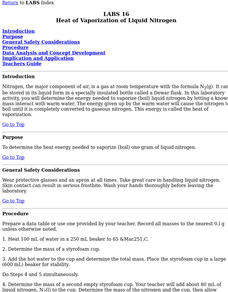University of Chicago
Don't Be Too Flaky
Snow, ice, and water are all composed of H2O. Does that mean they all have the same volume? Discover the ways that the densities of these substances determine their volumes, and how they change based on their current states of...
Curated OER
What is Wind Chill?
Students calculate wind chill using a mathematical formula. In this earth science lesson, students compare the wind chill in Antarctica to that of their local area. They explain how this can lead to hypothermia.
Curated OER
Activity #14 Floating Bubbles
Students comprehend that Carbon dioxide gas is relatively easy to generate. They comprehend that one way to produce it is with dry ice. Pupils comprehend that carbon dioxide gas can also be produced by combining baking soda with vinegar.
Curated OER
Heat of Vaporization of Liquid Nitrogen
Young scholars determine the heat energy needed to vaporize (boil) one gram of liquid nitrogen.
Curated OER
Wilderness Training
Students see that there are many different kinds of wilderness. They study equipment and supplies to see how they differ for different types of wilderness experiences. They discuss ways to allow access to wild places without damaging them.
Curated OER
Deadly Ascent
High schoolers explore some of Earth's extreme environments and the possible dangers they present. They describe some of the potential dangers found in extreme environments around the world. Students discuss ways to deal with potential...
Curated OER
Wilderness Training
Students explore how to prepare for a wilderness journey. In this wilderness survival lesson, students construct a compass from a magnet and a sewing needle.
Curated OER
Kids Health: Frostbite
Learn the difference between frostnip and frostbite, and learn what to do if your or someone else is frostbitten.
PBS
Pbs Learning Media: Body Breakdowns at High Altitudes
This interactive feature from the NOVA: "Surviving Denali" Web site details the variety of ways the body can fail while climbing a high-altitude peak.








